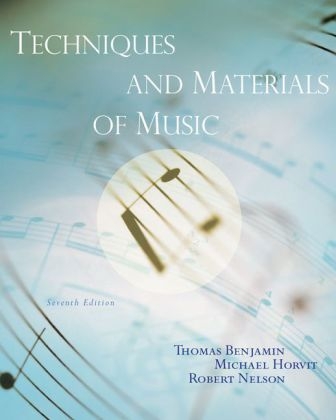
Techniques and Materials of Music
Schirmer Books,U.S. (Verlag)
978-0-495-50054-4 (ISBN)
- Titel erscheint in neuer Auflage
- Artikel merken
Designed to serve as a primary text for the first two years of college music theory, TECHNIQUES AND MATERIALS OF MUSIC covers all the basics of composition-including harmony, melody, and musical form. The authors present essential materials of common-practice music and an overview of 20th century techniques. Numerous hands-on exercises promote students' memorization and retention of key concepts. And the text's concise outline format, which has been enhanced for this edition, allows instructors maximum flexibility in choosing which materials, concepts, and techniques to emphasize in their course. An e-Workbook in PDF format provides more than 200 pages of exercises to complement TECHNIQUES AND MATERIALS OF MUSIC, 7th Edition.
Robert Nelson teaches music theory and composition at the Moores School of Music at the University of Houston. A composer in residence and music director of the Houston Shakespeare Festival for 17 seasons, he also has received numerous commissions for compositions and arrangements for the Houston Symphony Orchestra. Thomas E. Benjamin has recently retired as Chair of the Department of Music Theory at the Peabody Conservatory of the Johns Hopkins University. A composer, conductor, performer, and music theorist with more than 40 compositions published and recorded, he also holds fellowships and awards from the MacDowell Colony, Yaddo, and the National Endowment for the Arts. Michael Horvit is Professor Emeritus of Composition and Theory at the Moores School of Music at the University of Houston. His works range from solo instrumental and vocal pieces to large symphonic and choral compositions and operas, all widely performed in the United States, Europe, Japan and Israel. In addition to CDs with the Albany label, he has published with C.F. Peters, MorningStar, Recital Publications, Shawnee Press, E.C. Schirmer, Southern and Transcontinental. He received the Martha Baird Rockefeller Award as well as honors from the National Endowment for the Arts.
Part I: RUDIMENTS.
1. The Great Staff and Piano Keyboard. 2. Accidentals. 3. Intervals. 4. Major and Minor Scales. 5. Key Signatures. 6. Triads. 7. Meter and Rhythm.
Part II: DIATONIC MATERIALS.
1. Triads in Root Position. 2. The Tonic Triad in Root Position. 3. Connection of Tonic and Dominant Triads in Root Position. 4. The Dominant Seventh Chord in Root Position. 5. Connection of Tonic and Subdominant Triads in Root Position. 6. Connection of Subdominant and Dominant Triads in Root Position. 7. Cadences Employing the Tonic, Subdominant, and Dominant Triads in Root Position. 8. The Cadential Tonic Six-Four Chord. 9. Tonic, Subdominant, and Dominant Triads in First Inversion. 10. The Supertonic Triad. 11. Inversions of the Dominant Seventh Chord. 12. Linear (Embellishing) Six-Four and Other Chords. 13. Submediant and Mediant Triads in Root Position and First Inversion. 14. The Leading Tone Triad. 15. Variant Qualities of Triads. 16. The Sequence. 17. The Supertonic Seventh Chord. 18. The Leading Tone Seventh Chord. 19. Other Diatonic Seventh Chords.
Part III: CHROMATIC MATERIALS.
1. Secondary (Applied, Borrowed) Dominants. 2. Modulation. 3. Linear (Embellishing) Diminished Seventh Chords. 4. The Neapolitan Triad. 5. Augmented Sixth Chords. 6. Modulation by Other Means. 7. Ninth Chords.
Part IV: TWENTIETH-CENTURY MATERIALS.
1. Twentieth-Century Techniques: General Comments. 2. Further Concepts for Analysis. 3. Rhythmic and Metric Devices. 4. Tertian Harmony. 5. The Diatonic (Church) Modes. 6. Pandiatonicism. 7. Exotic (Artificial, Synthetic) Scales. 8. Quartal and Secondal Harmony. 9. Polyharmony and Polytonality. 10. Free Atonality. 11. Twelve-Tone Serialism. 12. Additional Contemporary Procedures.
Part V: REFERENCE MATERIALS.
1. Musical Calligraphy. 2. The Harmonic Series. 3. Nonharmonic (Nonchord) Tones. 4. Relative and Linear Motion. 5. Guidelines for Voice Leading in Strict Four-Part Writing. 6. Guidelines for Doubling in Strict Four-Part Writing. 7. Checklist for Part Writing. 8. Chord Functions in Tonal Music. 9. Figured-Bass Symbols. 10. Procedure for Harmonizing a Figured Bass. 11. Procedure for Harmonizing a Melody. 12. Models for Expansion and Elaboration. 13. Cadence and Phrase Structure. 14. Typical Phrase Variants. 15. The Motive. 16. The Sequence. 17. Textures. 18. An Introduction to Tonal Melody. 19. An Introduction to Tonal Counterpoint. 20. Form. 21. Checklist for Analysis. 22. Composition Checklist. 23.Instrumental Ranges and Transpositions.
Bibliography.
Index.
| Sprache | englisch |
|---|---|
| Maße | 205 x 256 mm |
| Gewicht | 771 g |
| Themenwelt | Kunst / Musik / Theater ► Musik ► Musikgeschichte |
| ISBN-10 | 0-495-50054-2 / 0495500542 |
| ISBN-13 | 978-0-495-50054-4 / 9780495500544 |
| Zustand | Neuware |
| Haben Sie eine Frage zum Produkt? |
aus dem Bereich



